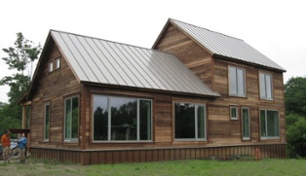
LEED, Passive House and Pretty Good Houses- Designing Better Buildings
7/21/2014
LEED, Passive House and Pretty Good Houses- Designing Better Buildings
There are many green building guidelines, programs, standards and certifications available in the US and Canada. The best green building approaches cover many elements of the building such as energy efficiency, water efficiency, resource efficiency, responsible site management, and improved indoor air quality. Guidelines, programs, standards and certifications that only address one aspect of green building, such as energy efficiency can create success in one green building principle but issues in others. As an example, we see this across the country with buildings that are very energy-efficient but don’t have HRV or ERV fresh air ventilation and as a result experience indoor air quality issues. Below is a brief introduction into LEED, Passive House, and Pretty Good Houses
LEED Rating Systems
LEED stands for Leadership in Energy & Environmental Design. Builders who wish to receive LEED certification for their projects must first satisfy set prerequisites. As the project progresses, points are awarded to determine different LEED certification levels. There are five main LEED rating systems.
These LEED rating systems are broadly categorized in order to apply to virtually any type of building and project. Project teams that wish to receive LEED certification will first select the rating system that best suits their project. The teams will then use the system’s credits, which are in place to guide the design process and operational decisions of the team.
The five main LEED rating systems are as follows:
- Building Design and Construction (BD+C): newly constructed buildings or major renovations
- Interior Design and Construction (ID+C): complete interior fit-outs, such as commercial interiors, hospitality, and retail
- Building Operations and Maintenance (O+M): improvement work on existing buildings or little to no construction
- Neighborhood Development (ND): any stage of new land development or redevelopment projects
- Homes: single family homes, multi-family one to three story low-rise homes, or multi-family four to six story mid-rise homes
LEED Certification Levels
The LEED certification level of each project is determined by the number of points it earns. These points are based on credits that differ among rating systems. Credit categories are pursued by project teams during the course of the building project.
There are four LEED certification levels based on the number of points a project earns:
- Certified: 40 to 49 points
- Silver: 50 to 59 points
- Gold: 60 to 79 points
- Platinum: 80 or more points
For more information, please visit http://www.usgbc.org/certification
History of Passive House
The concept of the Passive House originated in Germany. The term was derived from the German term Passivhaus. The concept was first introduced in May 1988, and the first Passivhaus residences were constructed in 1990 in Darmstadt, Germany. In September 1996, the Passivhaus-Institut, or Passive House Institute, was founded in Darmstadt. Since then, the Passive House movement has grown to exceed tens of thousands of houses built across the world, with the count constantly growing.
Passive House Benefits
Passive House is a building standard that provides significant benefits to individuals and the environment. The Passive House design helps to improve the quality, performance, and sustainability of buildings. It drastically cuts energy use, which translates to significant savings for those who live in and own Passive House buildings.
Passive Houses provide the following benefits, among many others:
- Roughly 60 to 80 percent in energy savings for building owners
- Consume roughly 90 percent less energy for heating and cooling
- Efficient use of the sun, internal heat sources and heat recovery, making large conventional heating systems unnecessary even in cold winters (some small space heating often still required)
- Consistent and continuous supply of fresh air from the controlled ventilation
- Environmentally friendly due to low energy and fossil fuel use
- High level of comfort its occupants
Passive House Certification
In order to qualify as a Passive House, a building must meet strict criteria. The three primary criteria for qualification discuss the building’s annual cooling and heating demands, the total energy consumption per year, and the volume of air the building leaks per hour. Additionally, there are a number of other considerations and recommendations for ensuring that a Passive House is as energy-efficient as possible.
For more information, please visit http://passiv.de/en/
Pretty Good House Guidelines
A Pretty Good House has no certification requirements but rather guidelines to help the homeowner and building professionals meet building performance goals.
Pretty Good House guidelines cover issues such as insulation, foundation, heating and cooling systems, ventilation, water management systems and so on. Individuals then have the freedom to adopt guidelines as they see fit. The Pretty Good House guidelines are optimized to suit buildings in different regions. This system is in place so that homes can be better tailored to function more efficiently in their respective climates.
A rough guideline for a Pretty Good House covers best practices for factors such as:
- Site considerations
- General guidelines
- Design
- Building envelope
- Foundations
- Mechanical systems
- Performance
- Windows
- Material finishes
For more information and/or to join the previous discussion on Green Building Advisor, please visit http://www.greenbuildingadvisor.com/blogs/dept/green-building-blog/pretty-good-house-better-building-standard
